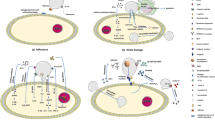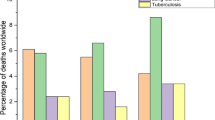Abstract
Tuberculosis is the single most serious infectious disease worldwide. The respiratory tract is the primary site of infection by Mycobacterium tuberculosis (MTB). A number of immunogenic components of the cell wall of MTB, if delivered to the lungs as aerosols, can be used to study the local immune response. The site of deposition of these aerosols can be employed to control their residence time in the lungs. Muramyl dipeptide (MDP) aerosols were delivered to alveolar macrophages in the lungs of rodents. Guinea pig macrophages harvested by bronchoalveolar lavage were examined by differential interference contrast microscopy for morphological changes indicative of activation. Bronchoalveolar lavage fluid was analyzed for the presence of alkaline phosphatase, lactate dehydrogenase, N-acetyl-glucosaminidase (NAG), and total protein content. Rat alveolar macrophages were studied for the production of nitric oxide, by induction of nitric oxide synthase. Twenty-four hours following exposure to an aerosol of MDP, alveolar macrophages exhibited morphological characterstics (spreading and pseudopodia), enzyme activity (NAG 50% above control), and production of the reactive intermediate nitric oxide. Rat macrophages subjected to aerosol exposure to MDP when challenged with a second dose of MDP or lipopolysaccharide exhibited a linear dose response as measured by nitric oxide production. These studies indicate that the topical delivery of an MTB bacterial cell wall component. muramyl dipeptide, results in activation of alveolar macrophages. This approach may be useful in elucidating elements of the immune response to MTB.
Similar content being viewed by others
References
Daniel T, Ellner J, Immunology of Tuberculosis. In: Reichman L, Hershfield E, eds. Tuberculosis. New York: Marcel Dekker, 1993:75–101.
Pelczar M., Chan E, Krieg N. Microbiology. New York: McGraw-Hill; 1986:815–818.
Lederer E. Recent progress in the study of natural and synthetic immunomodulators derived from bacterial cell walls. In: Yamamura Y, Kotani S, eds. Immunomodulation by Microbial Products and Related Synthetic Compounds. Princeton, NJ: Excerpta Medica, 1992:3–16.
Burleson G. Pulmonary immunocompetence and pulmonary immunotoxicology. In: Smialowicz R, Holsapple M., eds. Experimental Immunotoxicology. Boca Raton, FL: CRC Press; 1995:119–141.
Fidler I Systemic macrophage activation with liposomeentrapped immunomodulators for therapy of cancer metastases Res. in Immunol. 1992;143:199–204.
Phillips N, Chedid L, Bernard J, Level M, Lefrancier P. Induction of murine macrophage tumoricidal activity and treatment of experimental pulmonary metastases by liposomes containing lipophilic muramyl dipeptide analogs. J Biol Resp Mod. 1987;6:678–690.
Sone S, Tachibana K, Shoho M, Ogushi F, Tsubura E. Potential value of liposomes containing muramyl dipeptide for augmenting the tumoricidal activity of human alveolar macrophages. J Biol Resp Mod. 1984;3:185–194.
Phillips N, Moras M, Chedid L, et al. Activation of macrophage cytostatic and cytotoxic activity in vitro by liposomes containing a new lipophilic muramyl peptide derivative, MDP-L-alanyl-cholesterol (MTP-CHOL). J Biol Resp Mod. 1985; 4:464–474.
Hickey A. Summary of common approaches to pharmaceutical aerosol administration. In: Hickey A, ed. Pharmaceutical Inhalation Aerosol
Technology. New York: Marcel Dekker; 1992:255–288.
Altiere R, Thompson D. Physiology and pharmacology of the lung. In: Hickey A, ed. Inhalation Aerosols: Physical and Biological Basis for Therapy, New York: Marcel Dekker, 1996:85–137.
Hickey A, Suarez S, Bhat M, et al. Efficacy of rifampicinpoly(lactide-co-glycolide) microspheres in treating tuberculosis. In: Dalby R, Byron P, Farr S, eds. Respiratory Drug Delivery VI. Buffalo Grove, IL: Interpharm Press; 1998:201–209.
Chaffee V. Surgery of laboratory animals. In: Melby E, Altman N, eds. Handbook of Laboratory Animal Science. Boca Raton, FL: CRC Press.
1974;263
Seyler I, Morin C, Barratt G, Appel M, Devissaguet J-P, Puisieux F. Induction of macrophage NO-synthase by an immunomodulator entrapped within polymeric nanocapsules. Eur J Pharm Biopharm. 1995;41:49–54.
14. Fleisch J, Armstrong C, Roman C, et al. Recombinant human secretory phospholipase A2 released thromboxane from guinea pig bronchoalveolar lavage cells: in vitro and ex vivo evaluation of a novel secretory phospholipase A2 inhibitor. J Pharn Exp Ther. 1996;278:252–257.
15. Neldon D, Lange R, Rosenthal G, Comment C, Burleson G. Macrophage nonspecific phagocytosis assays. In: Burleson G, Dean J, Munson A, eds. Methods in Immunotoxicology. Vol. 2. New York: Wiley-Liss; 1995:39–57.
16. Leibovitz A, Stinson I, McComb III W, McCoy C, Mazur K, Mabry N. Classification of human colorectal adenocarcinoma cell lines. Cancer Res. 1976;36:4562–4569.
17. Gibaldi M. What is nitric oxide and why are so many people studying it? J Clin Pharmacol. 1993;33:488–496.
18. Jorens P, Van Overeld F, Bult H, Vermeire P, Herman A. Serine-protease inhibitors modulate nitric oxide-synthase activity of alveolar macrophages. Agents Actions. 1992;36:243–247.
19. Pettis R, Hall I, Hickey A. Effect of muramyl dipeptide aerosols on guinea pig alveolar macrophages. Pharm Res. 1996;13:S166.
20. Pettis R, Hickey A. Aerosol delivery of peptide immunomodulators to rodent lungs. In: Tam J, Kaumaya P, eds. Peptides: Frontiers of Peptide Science. Boston, MA: Kluwer Academic Publishers, 1999:845–846.
Author information
Authors and Affiliations
Additional information
Published August 17, 2000
Rights and permissions
About this article
Cite this article
Pettis, R.J., Hall, I., Costa, D. et al. Aerosol delivery of muramyl dipeptide to rodent lungs. AAPS PharmSci 2, 25 (2000). https://doi.org/10.1208/ps020325
Received:
Accepted:
Published:
DOI: https://doi.org/10.1208/ps020325




